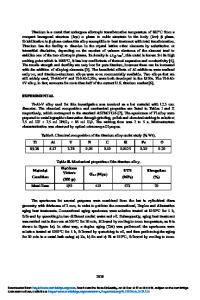Quantitative Ruthenium Method for Analysis of Nitrogen Ion-Implanted Titanium Alloy (Ti-6AI-4V) and the Effect on Bacter
- PDF / 1,060,082 Bytes
- 10 Pages / 420.48 x 639 pts Page_size
- 49 Downloads / 206 Views
QUANTITATIVE RUTHENIUM METHOD FOR ANALYSIS OF NITROGEN ION-IMPLANTED TITANIUM ALLOY (Ti-6AI-4V) AND THE EFFECT ON BACTERIAL ADHERENCE BEVERLY L. GIAMMARA* JAMES M. WILLIAMS" DAVID J. BIRCH* AND JOANNE J. DOBBINS*** • University of Louisville, Analytical Electron Microscopy Laboratory, Graduate Programs & Research, Louisville, KY 40292 Oak Ridge National Laboratory, Solid State Division, Oak Ridge, TN 37831 * Bellarmine College, Department of Biology, Louisville, KY 40205
ABSTRACT The effects of nitrogen ion implantation of Ti-6AI-4V alloy on growth of Pseudomonasaeruginosa bacteria on surfaces of the alloy have been investigated. Results for ion implanted samples were compared with controls with similarly smoothly polished surfaces and with controls that had intentionally roughened surfaces. The test consisted of exposing sterile alloy samples to a microbiological broth, to which 24 hour-old cultures of Pseudomonas aeruginosa had been added. After bioassociation at normal temperature 371C, bacteria adhering to the surface were fixed and treated with a new ruthenium tetroxide staining method, and quantified by use of scanning electron microscopy (SEM), back-scattered electron imaging and EDAX energy dispersive microanalysis. For smooth samples of the alloy, after a 12 hour growth period, the retained bacteria (revealed by the biologically incorporated ruthenium), decreased monotonically with nitrogen dose out to a total fluence of approximately 7 X 1017/cm 2 in an affected depth of approximately 0.1500 pm. The SEM confirmed that the Pseudomonas aeruginosa adhered equally to control materials. The ruthenium studies revealed that the amount
of bacterial adhesion is indirectly proportional to the nitrogen ion implantation of the titanium. The greater the percentage of nitrogen ion implantation in the titanium alloy, the less bacteria colonized the disk.
INTRODUCTION Two of the world's long-term permanent Jarvik-7 artificial hearts (TAH) were examined at autopsy and were intensely studied by a multiplicity of methods. By the use of microbiology, scanning and transmission electron microscopy, the colonization of bacteria on all biomaterial surfaces was determined [1,2,3,4,5]. Further studies were performed on the component biomaterials to determine the factors characteristic of bacterial adhesion. It was found that a rough surface as compared to a smooth surface altered the amount of bacterial adhesion to the biomaterials at body temperature, but a feverish condition at 401C did not enhance nor hinder bacterial growth [6,71. Another study of seven polymers determined that the cohesive energy density (CED) value of any one polymer could not be used to predict its success as a biomaterial in which the properties of low bacterial adhesion was the main consideration [8]. However, the methodology [2,6,9,101 of these studies was utilized to study bioassociation of polyurethane, Teflon, and polyvinyl chloride [6,11]. The statistical analysis for these three biomaterials indicated a significant Mat. Res. Soc. Symp. Proc. Vol.
Data Loading...











